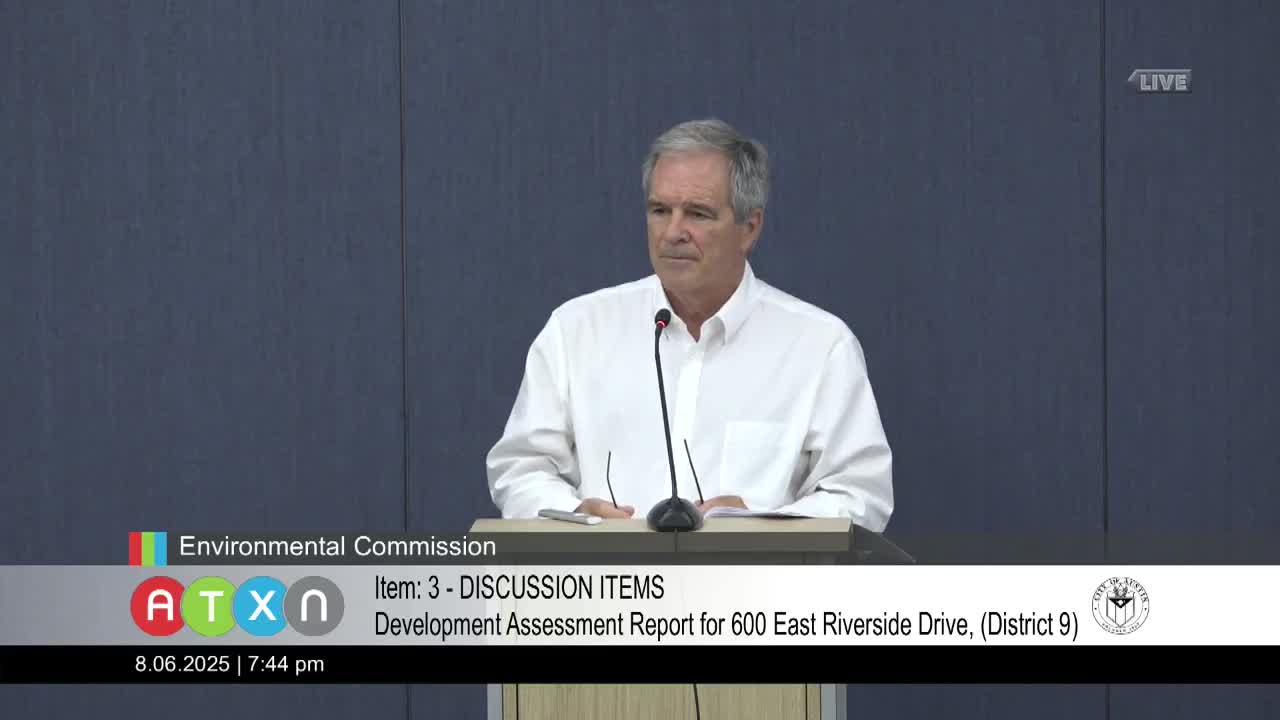Austin Commissioners Debate Unique Development Plans for South Central Waterfront
August 06, 2025 | Austin, Travis County, Texas
This article was created by AI summarizing key points discussed. AI makes mistakes, so for full details and context, please refer to the video of the full meeting. Please report any errors so we can fix them. Report an error »

In a recent meeting of the Austin Environmental Commission, discussions centered around the future of the South Central Waterfront and the potential redevelopment of unique properties along the river. As city officials gathered under the bright lights of city hall, the conversation quickly turned to the importance of maintaining accessibility and environmental integrity in the face of new developments.
Commissioner Bridal raised concerns about the nature of proposed developments, emphasizing the need for truly exceptional projects that enhance the waterfront rather than simply adding to the existing landscape. He pointed out that while the city has unique properties along the river, recent approvals, such as auto dealerships, do not align with the vision for a vibrant and distinctive waterfront. "We need to think about whether this is truly exceptional or just another development," he stated, urging his colleagues to consider the long-term implications of their decisions.
The discussion also touched on the balance between development and public good, particularly regarding water quality. Vice Chair Kerner sought clarity on the differences between the waterfront overlay and Planned Unit Developments (PUDs), questioning whether transitioning to a PUD would compromise environmental standards. Staff members assured the commission that any redevelopment would adhere to stringent stormwater control measures, ultimately improving water quality compared to the current state.
As the meeting progressed, the commissioners expressed a shared commitment to ensuring that any new developments contribute positively to the community and the environment. The overarching sentiment was clear: Austin's waterfront should not only be a place for development but also a space that fosters connection, accessibility, and ecological health.
With the future of the South Central Waterfront hanging in the balance, the commission's deliberations reflect a broader conversation about urban development in Austin. As they navigate the complexities of growth, the challenge remains to create spaces that are not only functional but also exceptional, preserving the unique character of the city while embracing the opportunities that lie ahead.
Commissioner Bridal raised concerns about the nature of proposed developments, emphasizing the need for truly exceptional projects that enhance the waterfront rather than simply adding to the existing landscape. He pointed out that while the city has unique properties along the river, recent approvals, such as auto dealerships, do not align with the vision for a vibrant and distinctive waterfront. "We need to think about whether this is truly exceptional or just another development," he stated, urging his colleagues to consider the long-term implications of their decisions.
The discussion also touched on the balance between development and public good, particularly regarding water quality. Vice Chair Kerner sought clarity on the differences between the waterfront overlay and Planned Unit Developments (PUDs), questioning whether transitioning to a PUD would compromise environmental standards. Staff members assured the commission that any redevelopment would adhere to stringent stormwater control measures, ultimately improving water quality compared to the current state.
As the meeting progressed, the commissioners expressed a shared commitment to ensuring that any new developments contribute positively to the community and the environment. The overarching sentiment was clear: Austin's waterfront should not only be a place for development but also a space that fosters connection, accessibility, and ecological health.
With the future of the South Central Waterfront hanging in the balance, the commission's deliberations reflect a broader conversation about urban development in Austin. As they navigate the complexities of growth, the challenge remains to create spaces that are not only functional but also exceptional, preserving the unique character of the city while embracing the opportunities that lie ahead.
View full meeting
This article is based on a recent meeting—watch the full video and explore the complete transcript for deeper insights into the discussion.
View full meeting
